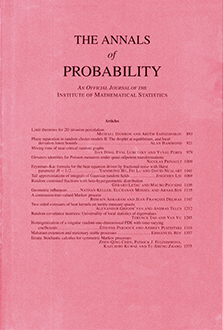Abstract
We investigate the asymptotic behavior of random paths on a graded graph which describes the subword order for words in two letters. This graph, denoted by $\mathcal{Z}$, has been introduced by Viennot, who also discovered a remarkable bijection between paths on $\mathcal{Z}$ and sequences of permutations. Later on, Gnedin and Olshanski used this bijection to describe the set of Gibbs measures on this graph. Both authors also conjectured that the Martin boundary of $\mathcal{Z}$ should coincide with its minimal boundary. We give here a proof of this conjecture by describing the distribution of a large random path conditioned on having a prescribed endpoint. We also relate paths on the graph $\mathcal{Z}$ with paths on the Young lattice, and we finally give a central limit theorem for the Plancherel measure on the set of paths in $\mathcal{Z}$.
Citation
Pierre Tarrago. "Zigzag diagrams and Martin boundary." Ann. Probab. 46 (5) 2562 - 2620, September 2018. https://doi.org/10.1214/17-AOP1234
Information





